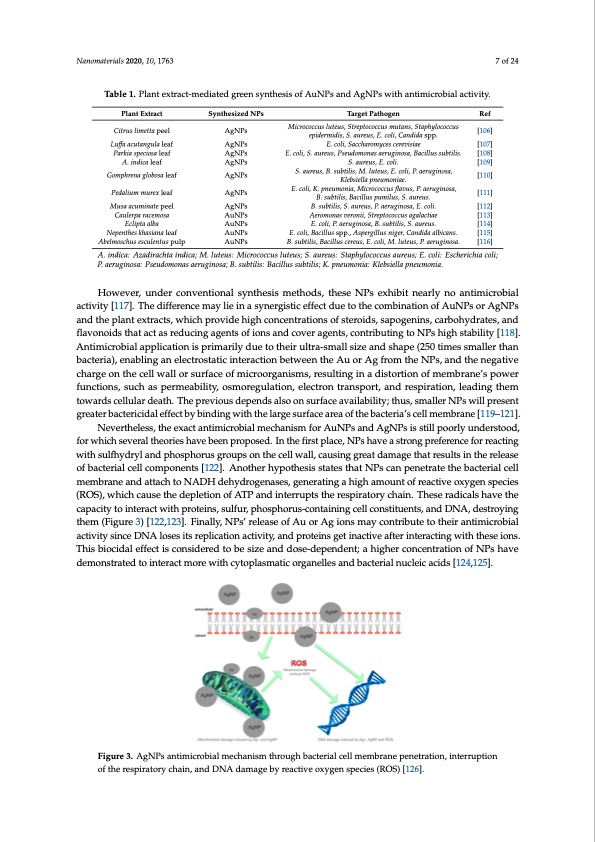
PDF Publication Title:
Text from PDF Page: 007
Nanomaterials 2020, 10, 1763 7 of 24 Table 1. Plant extract-mediated green synthesis of AuNPs and AgNPs with antimicrobial activity. Plant Extract Citrus limetta peel Luffa acutangula leaf Parkia speciosa leaf A. indica leaf Gomphrena globosa leaf Pedalium murex leaf Musa acuminate peel Caulerpa racemosa Eclipta alba Nepenthes khasiana leaf Abelmoschus esculentus pulp Synthesized NPs AgNPs AgNPs AgNPs AgNPs AgNPs AgNPs AgNPs AuNPs AuNPs AuNPs AuNPs Target Pathogen Micrococcus luteus, Streptococcus mutans, Staphylococcus epidermidis, S. aureus, E. coli, Candida spp. E. coli, Saccharomyces cerevisiae E. coli, S. aureus, Pseudomonas aeruginosa, Bacillus subtilis. S. aureus, E. coli. S. aureus, B. subtilis, M. luteus, E. coli, P. aeruginosa, Klebsiella pneumoniae. E. coli, K. pneumonia, Micrococcus flavus, P. aeruginosa, B. subtilis, Bacillus pumilus, S. aureus. B. subtilis, S. aureus, P. aeruginosa, E. coli. Aeromonas veronii, Streptococcus agalactiae E. coli, P. aeruginosa, B. subtilis, S. aureus. E. coli, Bacillus spp., Aspergillus niger, Candida albicans. B. subtilis, Bacillus cereus, E. coli, M. luteus, P. aeruginosa. Ref [106] [107] [108] [109] [110] [111] [112] [113] [114] [115] [116] A. indica: Azadirachta indica; M. luteus: Micrococcus luteus; S. aureus: Staphylococcus aureus; E. coli: Escherichia coli; P. aeruginosa: Pseudomonas aeruginosa; B. subtilis: Bacillus subtilis; K. pneumonia: Klebsiella pneumonia. However, under conventional synthesis methods, these NPs exhibit nearly no antimicrobial activity [117]. The difference may lie in a synergistic effect due to the combination of AuNPs or AgNPs and the plant extracts, which provide high concentrations of steroids, sapogenins, carbohydrates, and flavonoids that act as reducing agents of ions and cover agents, contributing to NPs high stability [118]. Antimicrobial application is primarily due to their ultra-small size and shape (250 times smaller than bacteria), enabling an electrostatic interaction between the Au or Ag from the NPs, and the negative charge on the cell wall or surface of microorganisms, resulting in a distortion of membrane’s power functions, such as permeability, osmoregulation, electron transport, and respiration, leading them towards cellular death. The previous depends also on surface availability; thus, smaller NPs will present greater bactericidal effect by binding with the large surface area of the bacteria’s cell membrane [119–121]. Nevertheless, the exact antimicrobial mechanism for AuNPs and AgNPs is still poorly understood, for which several theories have been proposed. In the first place, NPs have a strong preference for reacting with sulfhydryl and phosphorus groups on the cell wall, causing great damage that results in the release of bacterial cell components [122]. Another hypothesis states that NPs can penetrate the bacterial cell membrane and attach to NADH dehydrogenases, generating a high amount of reactive oxygen species (ROS), which cause the depletion of ATP and interrupts the respiratory chain. These radicals have the capacity to interact with proteins, sulfur, phosphorus-containing cell constituents, and DNA, destroying them (Figure 3) [122,123]. Finally, NPs’ release of Au or Ag ions may contribute to their antimicrobial activity since DNA loses its replication activity, and proteins get inactive after interacting with these ions. This biocidal effect is considered to be size and dose-dependent; a higher concentration of NPs have demonstrated to interact more with cytoplasmatic organelles and bacterial nucleic acids [124,125]. Nanomaterials 2020, 10, x FOR PEER REVIEW 8 of 25 Figure 3. AgNPs antimicrobial mechanism through bacterial cell membrane penetration, interruption Figure 3. AgNPs antimicrobial mechanism through bacterial cell membrane penetration, interruption of the respiratory chain, and DNA damage by reactive oxygen species (ROS) [126]. of the respiratory chain, and DNA damage by reactive oxygen species (ROS) [126]. Moreover, the antimicrobial activity shows differences related to bacterial cell wall composition. AuNPs and AgNPs exhibit higher activity against Gram-negative bacteria than to Gram-positive. The latter possesses a thick layer of peptidoglycan, consisting of linear polysaccharide chains cross-linked by short peptides, which creates a hard rigid structure for NPs to penetrate, while Gram-negative has a thinner that represents a feasible composition to pierce [127,128]. Nevertheless, works from Grace et al. and Padalia et al. reported that NPs’ antimicrobial activity could be enhanced by surfacePDF Image | Green Synthesis of Gold and Silver Nanoparticles from Plant Extracts

PDF Search Title:
Green Synthesis of Gold and Silver Nanoparticles from Plant ExtractsOriginal File Name Searched:
nanomaterials-10-01763.pdfDIY PDF Search: Google It | Yahoo | Bing
Turbine and System Plans CAD CAM: Special for this month, any plans are $10,000 for complete Cad/Cam blueprints. License is for one build. Try before you buy a production license. More Info
Waste Heat Power Technology: Organic Rankine Cycle uses waste heat to make electricity, shaft horsepower and cooling. More Info
All Turbine and System Products: Infinity Turbine ORD systems, turbine generator sets, build plans and more to use your waste heat from 30C to 100C. More Info
CO2 Phase Change Demonstrator: CO2 goes supercritical at 30 C. This is a experimental platform which you can use to demonstrate phase change with low heat. Includes integration area for small CO2 turbine, static generator, and more. This can also be used for a GTL Gas to Liquids experimental platform. More Info
Introducing the Infinity Turbine Products Infinity Turbine develops and builds systems for making power from waste heat. It also is working on innovative strategies for storing, making, and deploying energy. More Info
Need Strategy? Use our Consulting and analyst services Infinity Turbine LLC is pleased to announce its consulting and analyst services. We have worked in the renewable energy industry as a researcher, developing sales and markets, along with may inventions and innovations. More Info
Made in USA with Global Energy Millennial Web Engine These pages were made with the Global Energy Web PDF Engine using Filemaker (Claris) software.
Infinity Turbine Developing Spinning Disc Reactor SDR or Spinning Disc Reactors reduce processing time for liquid production of Silver Nanoparticles.
| CONTACT TEL: 608-238-6001 Email: greg@infinityturbine.com | RSS | AMP |